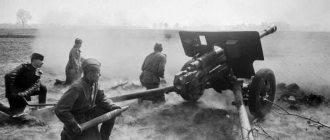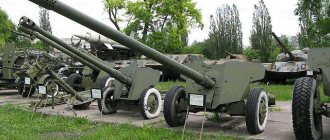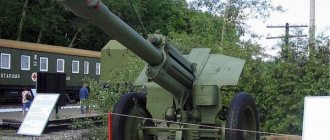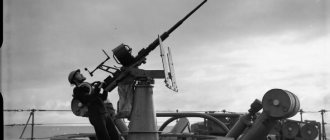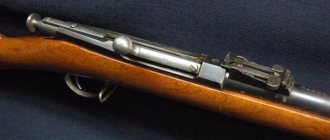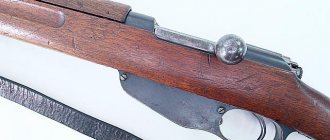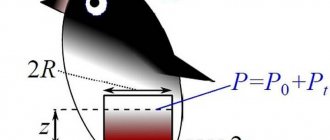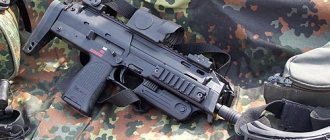Combat use
M-42 in the Malaya Zemlya Museum, Novorossiysk
M-42 in the Finnish Tank Museum, Parola
In the Great Patriotic War
The gun was intended to fight enemy tanks, self-propelled guns and armored vehicles. It was capable of successfully fighting all medium tanks of the Wehrmacht in 1942. However, the appearance in 1943 of significant quantities of new heavy tanks “Tiger”, “Panther” and the modernized Pz Kpfw IV Ausf H with a frontal armor thickness of 80 mm once again confronted the Soviet anti-tank artillery with the need to increase firepower. This was accomplished by re-adopting the 57 mm ZIS-2 anti-tank gun. However, thanks to the well-functioning production mechanism for the production of the M-42, the ability to fight the Panther and Pz Kpfw IV Ausf H by firing at the side and the high mobility of this weapon, it was left in production and in service with anti-tank units of rifle units. The British did the same - having developed a powerful 17-pounder, they kept the less powerful 6-pounder in production for exactly the same reasons.
The gun also had anti-personnel capabilities - it was equipped with a fragmentation grenade and buckshot. When exploded, a 45-mm fragmentation grenade produces 100 fragments that retain destructive power when scattered along the front by 15 m and in depth by 5-7 m. When fired, grapeshot bullets form a damaging sector along the front up to 60 m and in depth up to 400 m.
In his memoirs about the combat use of the gun:
The commander of the 6th Guards Army, General I.M. Chistyakov, wrote: “..... Marshal of Artillery Nikolai Nikolaevich Voronov once told us that in the 22nd Army, on the tops of trees..... they set up a firing position for an anti-tank gun. And visibility was good, and the shelling was wonderful. The cannon knocked out two or three enemy tanks, but then, with the next shot, it itself fell from the tree with the entire crew.”
American soldiers from the 5th Cavalry Regiment examine an M-42 captured from the North Korean army
Description of design
37-mm experimental Cheka gun.
Left view of the 37-mm airborne gun model 1944 is a light anti-tank artillery system with reduced recoil.
The internal structure of the barrel and the ballistics of the gun were taken from a 37-mm automatic anti-aircraft gun mod. 1939 (61-K). The gun barrel consists of a pipe, a breech and a muzzle brake. The pipe serves to direct the flight of the projectile and give it a rotational movement; the pipe channel is divided into a rifled part and a chamber, connected by a conical slope, into which the leading belt of the projectile rests during loading. The rifled part has 16 grooves of constant steepness with an inclination angle of 6°, the stroke length of the rifling is 30 calibers, the depth of the grooves is 0.45 mm, the groove width is 4.76 mm, and the field width is 2.5 mm. The chamber length is 251 mm, the chamber has a volume of 0.267 dm³. A powerful single-chamber muzzle brake serves to reduce recoil energy[7][8].
The gun's recoil devices, mounted inside a round casing, are built according to an original design, which is a hybrid of a double recoil system and a recoilless gun design with an inert mass. When fired, the gun barrel rolled back 90-100 mm, and a special cylindrical part, acting as an “inert mass,” disengaged from the barrel and rolled back inside the casing to a distance of 1050-1070 mm. Braking of the inertial mass occurs due to friction and compression of the knurled spring. There is no rollback brake. A shield cover 4.5 mm thick, designed to protect the crew from bullets, small fragments and the shock wave of a close explosion, is attached to the casing. Vertical guidance (VN) of the gun is carried out by a lifting mechanism, horizontal guidance (HN) by the gunner’s shoulder[5][8].
CHK-M1 installed on a Willys car
The machine is two-wheeled, with sliding frames, having permanent and driving coulters. The wheel travel is sprung, but is intended solely for moving the gun on the ground manually by crew. Towing the gun by car is not allowed due to possible destruction of the carriage. The gun is transported in Willys and GAZ-64 vehicles (one gun per vehicle), as well as in Dodge and GAZ-AA vehicles (two guns per vehicle). In addition, it is possible to transport the weapon on a one-horse cart or sleigh, as well as in the sidecar of a Harley Davidson motorcycle. If necessary, the gun is disassembled into three parts - the machine, the shield cover and the swinging part. For transportation of ammunition there is a special two-wheeled cartridge box[5][8].
The weapon can be transported by air either by landing or by parachute. In the first case, the A-7, G-11 gliders were used (each could carry one cannon with crews and ammunition) and BDP-2 (could transport two cannons with crews and ammunition), as well as the Li-2 aircraft (accommodating 2 motorcycles, gun and 5 people). When parachuting, a motorcycle with a cannon was placed on the external sling of an Il-4 bomber; the crew and ammunition were dropped from a Li-2 aircraft[5][8].
The gun crew consists of four people - a commander, a gunner, a loader and a carrier. When firing, the crew takes a prone position. The technical rate of fire reaches 25-30 rounds per minute, but the gun cannot fire for a long time at such an intense rate due to the risk of failure of the recoil devices. The transition time from the traveling position to the combat position is 80 seconds, without transferring the shield to the combat position (in the traveling position the shield rotates 90°) - 50 seconds[5].
Characteristics and properties of ammunition
Ammunition for 45-mm cannons 19-K and 53-K, which were also used in the M-42
- Ammunition range: armor-piercing 53-B-240
- armor-piercing tracer 53-BR-240
- armor-piercing tracer 53-BR-240SP
(solid) - armor-piercing tracer sub-caliber 53-BR-240P
- fragmentation 53-O-240
(steel) - fragmentation 53-O-240A
(steel cast iron) - Buckshot 53-Shch-240
- smoke 53-D-240
- Subcaliber armor-piercing: 0.85
- With a caliber armor-piercing projectile, the angle of impact is 90 degrees from the tangent plane to the armor (normally) at a distance of 500 m: 61
- meeting angle of 90 degrees from the tangent plane to the armor (normally) at a distance of 350 m: 82 (Through hole, side upper armor of the hull and turret. According to the shelling of a heavy Tiger tank at the training ground in 1943)
Self-propelled guns with ChK-M1
The gun could be installed on Willys and GAZ-64 vehicles using a special frame that allows horizontal guidance in a 30° sector. There was also the option of installing a cannon on a Harley Davidson motorcycle, and if necessary, shooting could be carried out even on the move, provided that the gun was driven on a flat road at a speed of no higher than 10 km/h[8].
In 1942, a project was developed for an airborne self-propelled artillery mount with a Cheka cannon and a machine gun called ChKIT-S1
. The installation had very small dimensions (height only 1.4 m) and weight (4 tons), and was designed on the basis of components of the T-70 light tank [5]. Information on the manufacture and testing of this installation was not found.
Organizational and staffing structure
Rifle formations.
45-mm guns of the 1937 model were assigned to anti-tank platoons of rifle battalions of the Red Army (2 guns), anti-tank batteries of rifle regiments (6 guns) and anti-tank battalions of rifle divisions (12 or 18 guns). According to State 04/600 dated July 29, 1941, the remaining intact guns were left only at the regimental level in anti-tank destroyer batteries in the amount of 6 pieces; in total there were 18 pieces in the SD.
Artillery.
They were also in service with individual anti-tank artillery units (regiments, brigades and the only one in the history of the Second World War, the 1st Anti-Tank Destroyer Division, whose formation took place at the end of May 1942 in Moscow on the basis of GKO Resolution No. 1607 of 04/16/1942, Directives of the Deputy NKO No. org/2/784837 dated 05/25/1942 as part of the 1st, 2nd, 4th fighter brigades according to the state 04/277), with regiments consisting of 4-5 4-gun batteries . The IPTABs consisted of 3 IPTAPs, but could also have other types of guns.
History of creation
The 45-mm anti-tank gun of the 1937 model was created in the design bureau of plant No. 8 in Podlipki under the leadership of M. N. Loginov by modifying the 45-mm gun of the 1932 model, which was the result of superimposing a 45-mm barrel on the carriage of a 37-mm anti-tank gun of the 1931 model year - a licensed copy of the gun.
A prototype of the new 45-mm anti-tank gun was manufactured at Plant No. 8 and received the factory index 53-K. After factory tests, it was sent to NIAP. During the tests in August - September 1937, 897 shots were fired, 184 of them from concrete. The system was tested by cart over a distance of 684 km. The 45-mm gun passed the firing tests. While transporting, the suspension spring broke.
In November 1937, Plant No. 8 produced a pilot series of 6 45-mm guns, which differed from the standard ones (1932 model). Of the six experimental guns No. 1, 2, 3, 4, and 6 were intended for military testing, and No. 5 was intended for the needs of the plant. In December 1937 - January 1938, these guns passed factory tests at the training ground of plant No. 8.
On January 22, gun No. 3 (barrel No. 0734) with the Y-3 limber was sent to NIAP, where it arrived on January 28. During factory testing at the factory, 605 rounds were fired from it. After delivery, NIAP employees disassembled the gun and then reassembled it incorrectly, as a result of which some of the parts were rendered unusable.
During field tests at NIAP, 1208 shots were fired (798 armor-piercing and 419 fragmentation projectiles). The rate of fire with a manual release was the same for both (models 1932 and 1937) guns when firing without aiming correction, and with a push-button (mechanical) release it was 13% higher than that of the 1932 model when firing armor-piercing shells and 6% higher than when firing fragmentation shells. During the firing, 16 semi-automatic failures were noted, including 3 with fragmentation shells and 13 with armor-piercing shells. Some of the failures occurred due to the quality of the cartridges. After the 281st shot, the semi-automatic inertia body screw broke. In general, the operation of semi-automatic equipment was considered satisfactory.
During field tests, the system covered 2074 km. Carriage speed on cobblestones is 30-35 km/h, on the highway 50-60 km/h, on rough terrain (without a front end) 15-30 km/h. The system was stable during transportation.
At the beginning of 1938, military tests were carried out on three 45-mm 53-K cannons (No. 1, 2 and 4 of the experimental series) with Y-3 limbers. 6 Komsomolets type tractors took part in the tests. During military tests, an average of 450 shots were fired per barrel, while the semi-automatic gun worked flawlessly. During military tests, the Moscow-Kharkov-Krasnodar run was carried out. After correcting minor flaws, you can begin serial production of the gun. On April 24, 1938, the 53-K was put into service under the name 45-mm anti-tank gun model 1937. On June 6, 1938, it was launched into mass production. Production was carried out at plant No. 235; a total of 24,670 units were produced until 1944 (including 14,670 in 1941-1944 at plant No. 235).
